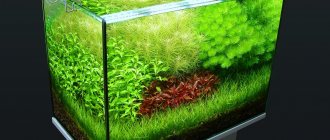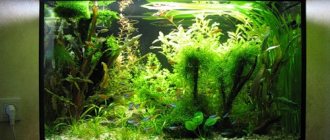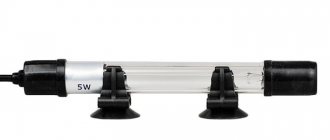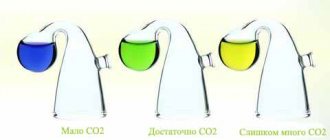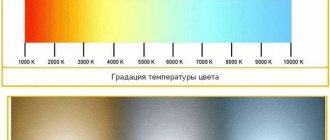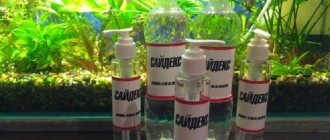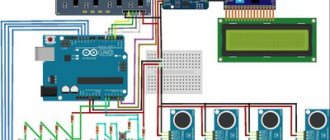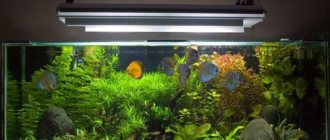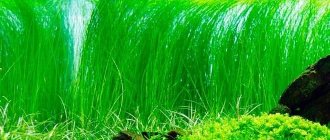Why do you need light in an aquarium?
Lighting is one of the main postulates of the normal functioning of the closed biological environment of an aquarium.
The normal functioning and even the very life of the inhabitants of the aquarium and aquatic plants depend on how its parameters are configured. If the light intensity and duration of illumination are not enough, the plants begin to turn brown, and then begin to rot and decompose, poisoning the water and fish. When there is an excess of light or its incorrect spectrum, the water “blooms”; the glass walls of the tank become covered with parasitic algae, which actively absorb beneficial microorganisms from the environment.
Without artificial lighting of a reservoir, it will not be possible to create the 12-hour daylight required by fish and plants, which will inevitably cause their degeneration.
The choice of light intensity, radiation spectrum and duration of illumination depends on the specific species of aquarium inhabitants.
How lighting affects CO2
Photosynthesis of aquarium plants does not depend on CO2 concentration, but on lighting. With light energy, plants convert water, CO2 and nutrients into tissue. In the absence of the required level of lighting, CO2 and nutrients are unclaimed, since photosynthesis does not occur.
A sign of photosynthesis is the formation of oxygen bubbles on the leaves of plants, which become covered with them a couple of hours after the light is turned on. This indicator is a visual sign that the condition of the aquarium is good and the lighting is organized correctly.
An important point in caring for aquarium inhabitants is monitoring oxygen saturation. So, at the beginning of daylight, oxygen saturation should be from 5 mg/l, and at the end - 8-10 mg/l. Compliance with these indicators indicates that the lighting is organized correctly.
Characteristics of aquarium lighting
From an electromechanical point of view, special technical requirements apply to aquarium lighting:
- The net volume of 1 liter of water should account for 0.1-0.3 W of power.
- For nocturnal, shade-loving fish, 0.2-0.4 W/l is sufficient. Shade-loving plants should also be planted in such light conditions, for example, cryptocoryne, vallinseria, Java moss.
- If there are not very many plants in an artificial pond, then a lighting power of 0.4-0.5 W/l is sufficient.
- Optimal illumination is considered to be 0.5-0.8 W/l. This is the norm for a beautiful aquarium with luxurious plants and fish.
- If the planting with aquatic plants is very dense or there are ground covers among them, then the illumination must be increased to 1 W/l. These are aquaspake or Dutch. They are also often called by the name of the famous Japanese aquarist Takashi Amano, creator of unique underwater gardens.
It must be remembered that the light intensity drops by 50% for every 10 cm of water of average transparency. But illumination depends not only on depth, but also on the surface area of the water, its condition (transparency) and the parameters of the tank itself.
It should also be remembered that the choice of plants for it depends on the lighting power of the aquarium, since neither fertilizing nor the forced supply of carbon dioxide will save them if the light intensity is insufficient.
This is explained by simple physical laws, because only light is a prerequisite for the process of photosynthesis - the conversion of water, carbon dioxide and fertilizers into plant tissue and oxygen.
A clear indication of this phenomenon can be the formation of oxygen bubbles on the leaves of aquatic plants a couple of hours after turning on the lighting in the aquarium. This is considered a sign of a healthy aquarium.
How long should the light be on in the aquarium?
Although light is very important for a planted aquarium, it should not be on constantly, since it is necessary to give the inhabitants of the underwater world a rest in the dark. Plants are divided into 3 groups according to the required lighting time:
- long-day;
- short-day;
- neutral.
For most plants, 12 hours of daylight is optimal. In bright light, the lighting period is reduced to 10 hours a day.
This is interesting! If the leaves on the tops of the limnophila and rotala begin to curl, it’s time to turn off the light.
Using additional lighting for an aquarium does not provide any benefits to plants. To extend the time for observing fish, you need to take a 2-3 hour break in lighting during the day, with the greatest supply of natural light. You can turn on the light at any time, but it is important to know that before and after the pause, the lighting must be continuous for at least 4 hours.
Lighting power standard
The simplest and most understandable way to calculate the illumination of an aquarium is considered to be the watt/liter ratio. But we must keep in mind that when dividing the lamp power by the number of liters of capacity, the result is something very, very arbitrary. And if we take this conditional indicator as a basis, then the lighting power standards for different types of aquariums will be as follows:
- in “banks”, where all the plants are artificial, there is enough illumination of 0.1-0.3 W/l;
- lamp power of 0.2-0.4 W/l is quite sufficient in aquariums, where most species of aquarium flora are able to tolerate low light levels;
- for containers with a minimum of vegetation, lamps with a power of 0.4-0.5 W/l are suitable;
- devices with a power of 0.5-0.8 W/l create optimal illumination in the “bank” for many representatives of the aquarium flora;
- in a home pond densely planted with vegetation, an illumination of 0.8-1 W/l is required.
For plant growth in an artificial pond, it is important that the light flux passes through the water column. Therefore, when determining the power of a light source, it is worth considering the possibility of adjusting it:
- water composition;
- tank height;
- properties of the material from which the aquarium is made.
Colorful temperature
Color temperature determines the composition of the visible spectrum of light emitted by a source. The color of lighting is not so important for fish as it is for aquarium plants. Taking into account this parameter, measured in Kelvin, the light for the “can” is selected. After all, color temperature affects the naturalness of the lighting of the underwater landscape. As the color temperature decreases, the proportion of red (warmer) increases, and the proportion of blue becomes less. A rise in CG leads to an increase in the proportions of blue and green, and accordingly the light will be colder.
For a marine aquarium, blue cold light is chosen. It is generally accepted that for plants it is worth choosing lamps of a more yellowish spectrum (6500-8000 K), and for better visual perception and more beautiful coloring of fish, sources of a pale yellow hue (5500-6500 K). The best effect is achieved by combining similar lamps.
Control of lighting operation
To ensure that aquarium lighting does not harm the inhabitants of the reservoir, a developed lighting regime is needed. Daily fluctuations in daylight hours should not be allowed. However, many find it difficult to constantly monitor the operation of lighting fixtures. The best solution to this problem is to use an outlet with a timer. This is the simplest device that automatically turns on/off the light at hours set on a special timer.
There are two types of such devices:
- Mechanical. In them, the timer time is set using a drum element. Such sockets are considered daily, since they operate automatically for no more than 24 hours.
- Electronic. Programming the operation of the device is performed by pressing keys on the electronic unit.
Do you need light in an aquarium at night?
An important question is whether to turn off the lights in the aquarium at night. There are two opposing points of view on this question. The first says that natural bodies of water are illuminated by the moon at night, and, therefore, night lighting for the aquarium is necessary (precisely night lighting, weaker, and not the one used during the day). And the second is that the aquarium does not need light at night.
Night lighting is not required for fish and plants, but rather for the owner for aesthetic reasons and out of interest in observing the night life of aquarium fish. In connection with the above, you can use a weak blue backlight that imitates the light of the moon.
But in any case, the main light must be turned off at night.
Normal aquarium lighting time
The following information will help you determine how many hours the light should be on in an aquarium with plants, and when you should turn the light on and off.
There are several options for calculating the standard lighting time for an aquarium. Key parameters to consider:
- volume of the aquarium, its depth,
- species of fish and plants,
- light bulbs used for lighting,
- water (fresh or sea).
Calculation using formulas does not provide a 100% guarantee of correct lighting, which can only be verified experimentally over time.
When using fluorescent lamps, the illumination is calculated from 0.3 Watt per liter of water in the aquarium, taking into account the following information:
- moderate illumination: 0.2-0.4 Watt/liter – in the presence of shade-loving fish (nocturnal, for example) and plants (cryptocorynes, Vallisneria, Java moss, some echinodorus);
- average: 0.4-0.5 Watt/liter – if the number of plants in the aquarium is limited;
- high: 0.5-0.8 Watt/liter – in 90% of cases suitable for lighting an aquarium with plants;
- high: 0.8-1 Watt/liter - an indicator that should be when densely planted with plants.
Another important parameter to take into account is that in water the light intensity decreases by approximately 50% every 10 cm. At the bottom of the aquarium, the illumination should not be lower than 60 Lux.
Interesting! Illumination is the ratio of luminous flux to its area. The unit of measurement is lux. Lux = lumens/m².
Luminous flux is a quantity characterizing the emission of light intensity per unit area. Measured in lumens.
Luminous efficiency is the ratio of the luminous flux to the power it consumes. Measured in Lumen/Watt.
The light output of fluorescent lamps is two to three times greater than that of incandescent lamps, and that of LED lamps is 7 times.
The main value when choosing the type and number of light bulbs is lux, information on which can be found on the light bulb packages themselves. The average for not very large and sparsely planted aquariums is 3000-4000 Lux. From 1000 to 10000Lx is an indicator sufficient for plant photosynthesis. But there is also a dependence on the depth of their growth. So, for narrow-leaved cryptocorynes, 400 lux is enough.
It must be remembered that different fish and plants have different lighting requirements.
There is another opinion regarding the required illumination. Takashi Amano, an aquarium designer, the creator of a new direction in the design of freshwater aquariums - “Natural Aquarium” - argues that the importance of the water surface area is important.
When calculating, you can also proceed from lumens. So, at a low level of lighting the indicator is 15-25 Lm/l, at an average level - 25-50 Lm/l, at a high level - 50 Lm/l.
The power of different types of lamps and their luminous flux are shown in the table below.
| Lamp power, Watt | Luminous flux, Lm | ||||
| incandescent | luminescent | LED | incandescent | luminescent | LED |
| 40 | 5-7 | 2-3 | 610 | 250 | 250 |
| 10-13 | 4-5 | 570 | 400 | 400 | |
| 15-16 | 6-10 | 340 | 700 | 700 | |
| 18-20 | 10-12 | 400 | 900 | 900 | |
| 60 | 25-30 | 12-15 | 955 | 1200 | 1200 |
| 40-50 | 18-20 | 735 | 1800 | 1800 | |
| 60-80 | 25-30 | 645 | 2500 | 2500 | |
| – | 30-40 | 711 | – | 3 500 | |
| – | 40-60 | 670 | – | 8 000 | |
| 75 | – | 80-120 | 940 | – | 12 000 |
| – | 140-160 | 960 | – | 20 000 | |
| 100 | – | 180-200 | 1581 | – | 30 000 |
Kaspar Horst recommends calculating illumination based on 30-50 lm per liter of aquarium volume (based on external dimensions).
And finally, the dependence of lighting on water. If the aquarium is with sea water, then you need to use more of the blue spectrum of light (in addition to the main lighting), and if it is with fresh water, then the proportion of the red spectrum to the blue spectrum is 5:1.
Choosing a light spectrum for an aquarium
The light spectrum is most important for plants, for fish - to a lesser extent.
In order to understand the importance of the light spectrum of artificial lighting, you need to imagine its changes in natural conditions.
During the day, the sun moves and its rays fall on the surface of the water at different angles. On a cloudy day, the natural spectrum is dominated by blue colors, with a light temperature of about 1,000 K (degrees Kelvin).
At lower temperatures the light spectrum is red.
On a bright sunny day it rises to 4,300-5,600 K and is in the white-yellow spectrum. The optimal figure is 5,000 K.
By creating “beautiful” red and blue lighting in an aquarium, inexperienced aquarists make a mistake that can cost the lives of many aquatic plants, and threads and beards will inevitably grow in the tank.
Lamps for an aquarium should be purchased powerful, having a wide spectrum and light temperature from 5,000 to 10,000 K.
Oddly enough, simple incandescent lamps have the best “warm yellow” sector. Therefore, despite their low efficiency and high cost of use, you should not completely abandon them.
Today, special incandescent lamps for plant illumination (phytolamps) of the LL family are produced, for example, Osram L 15 W/77, which can be used in combined lighting devices.
Plant lamps
These lamps have a pinkish light and are used both in aquariums and in greenhouses. Their pink light is due to the predominance of the red and blue parts of the spectrum, most needed for photosynthesis. Lamps with a color temperature of 2400–2700 °K are used.
Warm white lamps
These lamps are yellowish in color. Such lamps have a color temperature from 3000 °K to 6000 °K and are most often found in hardware stores. Under these lamps, the aquarium appears yellow and dimly lit, so they are chosen for aquariums with low lighting, or used in combination with cool white lamps to give it warmth.
Cool white lamps
In terms of spectral composition, their light is closest to that of the sun. These lamps provide the best display of fish and underwater scenery, and also have the most natural light, so they are used either alone or in combination with other lamps to “dilute” their light and give it a “natural” look. These lamps have a color temperature of 6000 °K.
Blue lamps
They are used mainly in marine aquariums, where, in combination with other light sources, they help recreate the specific conditions of tropical oceans, while simultaneously promoting the growth of corals, which largely depend on the photosynthesis of symbiont algae. These are lamps with spectra from 10,000 °K and above.
Light for tropical freshwater fish
The most common tropical fish come from rivers, streams and clear lakes in warm regions and are accustomed to bright sunlight and warming rays on a natural 12-hour cycle.
Therefore, to best recreate these conditions in an aquarium, you need to provide 12 hours of light per day, preferably with bright LEDs that penetrate the surface of the water, or use sunlight if the room in which the aquarium is placed is well lit.
Some species of tropical freshwater fish, such as tetras, may prefer low light. In this case, you need to leave enough hiding places in the aquarium so that these fish can escape there.
What lighting errors can lead to
If you do not take the choice of lighting in an aquarium seriously, you can cause irreparable harm to fish and plants:
- When daylight hours are too long, brown algae grow intensively, the water “blooms,” and a dark coating covers the walls and bottom. You have to use special chemicals, sanitize and “restart” the aquarium.
- Excessive extension of the period of active illumination is justified only with abundant planting of plants and a large amount of fertilizers for them, otherwise brown algae will quickly grow.
- Fish usually like partial shade, and aquatic plants need a lot of light, so it is necessary to properly regulate the periods and intensity of light or abandon abundant tropical thickets.
- The deeper the aquarium, the more powerful the lamps are needed, otherwise the plants at the bottom will begin to rot.
- Multi-colored lighting decorates the aquarium, but it should not be long-lasting, since the red and blue spectrum, for example, leads to the overgrowing of the reservoir with threadbare and beard.
Correctly calculated lamp power and the choice of a warm spectrum of lighting will help maintain the aquarium’s biosphere in balance and extend the life of fish and aquatic plants.
The use of special sockets with timers made it possible to use stepped aquarium lighting, in which the illumination is automatically adjusted throughout the day. That is, it is possible to reduce the light intensity, turn it off completely, turn it on, slowly increase and even intense radiation for the required number of hours.
Do plants need light?
Plants will not grow without light. For their development, the light must be on in the aquarium for 8 to 12 hours. At this time, they produce oxygen, absorb carbon dioxide and develop, that is, the process of photosynthesis occurs.
The brightness of the lighting is selected based on the types of crops planted in the aquarium. For example, cryptocarina, anubias, and hornwort will grow well in light levels of 30-40 Lm/l. But there are also more demanding plants that need much brighter light. For example, for the growth of red plants, lemongrass, lighting of 100 Lm/l is required. At night, plants do not need light.
Types of lamps
The water column of artificial reservoirs is illuminated with different light sources. The following types of lamps are used for this purpose:
- luminescent, having a gas-discharge light source. The light they provide in the aquarium is closest to daylight, which allows you to create natural living conditions for fish and vegetation. Moreover, for this purpose, LLs that are less powerful than, for example, incandescent lamps are needed. Most often, 3 types of fluorescent lamps are used in aquariums: T5, T8 and compact (CFL).
- metal halide lamps are one of the types of high-pressure gas discharge lamps. They differ from other GRLs in that they have special emitting additives. The basis of the MGL is a burner made of quartz glass or special ceramics. The burner is placed in a flask made of borosilicate glass, which acts as a light filter that cuts off hard UV radiation. Metal halide lights produce pure white daylight.
- LED If the diodes are selected correctly, they are capable of generating scattered light with a yellow or reddish spectrum. This is exactly the spectral composition that fish and plants need. LED lamps have the advantage of economical energy consumption, which is important for large tanks. A significant disadvantage of LED lamps is their high cost.
- Not so long ago, incandescent lamps in aquariums were the only lighting devices. But due to the strong heating, they are now rarely used. Mainly for temporary lighting in table lamps or floor lamps above the aquarium, but not near the water.
Incandescent lamps
Despite the low efficiency, the release of a large amount of heat with minimal efficiency, and a short operating period, conventional incandescent lamps have such an emission spectrum. It almost completely coincides with the solar one, that is, the one that is necessary for plants and other aquatic inhabitants.
Fluorescent lamps
Fluorescent lamps are often chosen by aquarists for several reasons:
- due to the dimensions of the glow area;
- variety of model range;
- absence of thermal radiation;
- sufficiently long service life.
However, in general, these devices do not have a radiation spectrum sufficient for normal lighting of aquariums. However, the industry produces specialized lamps of a similar operating principle that are capable of providing good illumination in aquariums of certain sizes.
Metal halide lamps
Metal halide lamps, which are often used to organize effective lighting in an aquarium, have improved characteristics:
- high power and large range;
- light output exceeding that of many modern light sources;
- long service life;
- the ability to create a light regime that practically coincides with natural light in natural bodies of water, that is, light that needs to be maintained for a certain period for aquarium plants and other aquatic life forms.
In addition, metal halide elements help to equip a Dutch or marine aquarium with good light and create contrasting lighting that will help the artificial ecosystem become a bright accent of the interior.
However, the thermal radiation of such a lamp dictates special conditions for the placement of the panel or spotlight, namely: a special suspended structure, which requires more careful calculation for aquariums that are planned to be illuminated with these devices, since placing such light sources close to the surface of the water can be harmful to plants .
LED lamps
The complex production technology of metal halide lamps does not allow making such a light source yourself, unlike equipment equipped with LEDs, which many aquarists design and assemble with their own hands.
In addition, preference is given to LED lamps for a number of reasons:
- economical energy consumption;
- operation from low voltage in the network;
- long period of operation.
Mercury vapor lamps
Mercury vapor lamps (HQL) are more expensive than fluorescent lamps and are used for deep tanks. They are especially useful for large marine aquariums. Mercury lamps are very powerful and produce a lot of heat, so they must be placed at least 20 cm above the surface of the water. They are rare, since due to the combination of characteristics, most aquarists prefer metal halide lamps to them.
Natural lighting and location of the aquarium
There is a misconception that placing an aquarium on a windowsill provides better lighting conditions. However, possible negative consequences of this decision:
- In summer, the water in the aquarium will become very hot,
- natural light promotes the active proliferation of green algae.
- the light passing through the water column and the glass of the window and aquarium loses intensity.
The duration of natural light should not exceed two hours.
It is best to install the aquarium on the side opposite the window. It is important to limit access to direct sunlight.
Do fish need light at night?
At night, lighting fixtures must be turned off. The only exception is when the container is located in a dark place where the sun's rays do not penetrate. In this case, it is necessary to use a lighting device during the daytime and leave a night light on at night.
LED lamps can also be used, which act as part of the decor and illuminate the container at night, giving it the necessary tone.
Should you leave the lights on in aquariums overnight?
Proper aquarium lighting is important for fish and plants, but they also need a period of darkness to allow them to rest and recuperate. Therefore, it is best to turn off your aquarium lights at night to mimic the natural light cycle of plants and fish.
Many newbies may not know, but fish do sleep, however most species do not have eyelids and are dependent on the owner to turn off the lights and provide them with enough hours of pure darkness for them to take a nap. Therefore, it is best to keep your aquarium lights on for the recommended 8 to 12 hours, then turn off the lights to mimic the natural day and night cycle.
If the fish becomes worried when the lights go out, it is worth turning off the overhead lights in the room an hour before the aquarium lights go out. This should give the fish eyes an hour to adjust to the lower light settings before total darkness.
For plants, you should also gradually reduce the light level before turning off the light completely.
Herbalist step lighting
With the stepped lighting method, the light intensity increases until it reaches a peak and then gradually decreases.
The method allows you to simulate the natural length of daylight in an aquarium and is distinguished by its effectiveness, and also helps to significantly reduce (even stop) the growth of algae.
How long should the light be on in the aquarium using the stepwise method?
In practice, stepped lighting is implemented as follows. Some of the lamps used shine all day, others – for a couple of hours. For example, when daylight is organized for the inhabitants of an aquarium at 9 o’clock, only some lamps shine for the first two hours, then the remaining ones are turned on for 5 hours. After which the same lamps shine as in the morning for the remaining two hours. The peak brightness of the light should not exceed the specified 5 hours.
To reduce the growth of algae at the initial stage of creating an aquarium, it is recommended to use a ratio of 3: 3: 3, that is, 3 hours in the morning and evening - less light, and 3 hours - peak light. After a month, you can switch to the 3:4:3 regime and stick to it in the future.
The type of aquarium plants should be taken into account. So, if they are slow-growing, then the regime will be 4:2;4, and if they are more demanding and/or fast-growing - 3:4:3. By the way, there is a special controller that will eliminate the need to constantly turn it on/off manually.
Tip: In winter, before turning on the light in the aquarium, it is better to turn on the light in the room first. This way, the fish will not experience stress from harsh, strong lighting.
What happens if you don't turn off the lights
Some aquarists claim that the fish need light in the aquarium at night to search for food in the dark. In addition, night lighting allows you to easily see the inhabitants of the reservoir. Following these assurances, aquarists make a mistake, because fish have special organs to search for food, and besides, most pets sleep peacefully in the dark. But if an artificial reservoir is illuminated around the clock, this will cause the following problems:
- Deterioration in the health of fish, since pets are programmed at the level of instincts to change day and night. Fish need to rest at night, and the light in the aquarium will interfere with this.
- In nature, there is no round-the-clock lighting, and the closer the conditions in the tank are to natural, the better the pets and plants develop and live longer.
- Increased level of aggressiveness in pets: some phenotypes, in the absence of a day change, show increased anger towards their relatives.
- The main problem with 24/7 lighting is algae. The longer the daylight hours in an artificial reservoir, the faster the development of harmful tiny organisms in the reservoir, which can lead to the death of all living things.
Light for cold water fish
In general, cold-water fish do not need excessive lighting. Only if the owner wants to admire the aquarium. Therefore, only 8 hours of light is enough.
If the tank has enough hiding places for them, even 12 hours of daylight is fine, especially if there are also light-loving plants in the aquarium.
To create an optimal habitat for cold-water species, the owner should try to adjust the aquarium's lighting to seasonal daylight hours, as in the temperate climate zone where most cold-water species originate.
Best Lamps for Saltwater Aquariums
Representatives of this category stand out for their power, allowing the light flux to pass to the very bottom without scattering. It is recommended to use them in deep, large containers. Sometimes these lamps have a function that imitates the light of the moon, which is important for the growth of coral reefs and the spawning of certain species of marine life.
JBL Solar Ultra Marine Day
4.9★★★★★editorial assessment
95% of buyers recommend this product
The white, coolish light of the lamp is ideal for a home pseudo-sea. This glow has a very beneficial effect on the growth of corals. The device has a high level of light output, so you don't have to worry about insufficient lighting at the bottom of the tank. The manufacturer guarantees 8000-10000 hours of uninterrupted operation of the lamp under favorable conditions.
Pros:
- Promotes the development of invertebrates;
- Easy to find on sale;
- Long service life;
- Low power consumption.
Minuses:
- Overpriced.
This lamp is ideal for a reef pond. To obtain excellent illumination and fluorescent results, it is recommended to combine it with Solar Ultra Marin Blue from the same manufacturer.
Hailea Extra Reef T5
4.8★★★★★editorial assessment
90% of buyers recommend this product
The model with a dominance of the blue-violet spectrum is suitable for the inhabitants of a marine aquarium, as it creates an imitation of the illumination of a coral reef at a depth of six meters. This light promotes the growth of unicellular organisms and corals.
Pros:
- Promotes coral growth;
- Excellent quality;
- Aesthetic appearance;
- Reasonable price.
Minuses:
- Rarely found in our stores.
Illumination with such a lamp will make your aquarium a copy of the seabed. Corals, sea fish and cichlids feel great in its light.
Hagen Marine Glo T8
4.6★★★★★editorial assessment
84% of customers recommend this product
A fluorescent lamp from a Canadian manufacturer produces a limited-spectrum blue glow, ideal for saltwater aquariums. Such lighting will create the appearance of the seabed in the aquarium. In addition to its decoration function, the lamp has a beneficial effect on the growth of corals and invertebrates, and stimulates plant photosynthesis.
Pros:
- Does not increase water temperature;
- Many power options (from 15 to 40 W);
- Suitable for aquariums of different sizes (length 45-120 cm);
- Durable.
Minuses:
- Over time, it loses its “useful” properties.
Marine Glo is suitable for home ponds with reef-dwelling invertebrates. Its light has a good effect on their fluorescent pigments. It is recommended to combine it with Life-Glo or Power-Glo lamps.
Flow-through carbon dioxide reactor for aquarium. User guide.
Today there are many ready-made solutions on the market, or rather devices designed to supply carbon dioxide to the aquarium. Such devices include a variety of diffusers made of plastic, metal or glass, as well as reactors with a built-in impeller or ceramic membranes. Undoubtedly, they very often cope with their intended purpose, but sooner or later they need to be cleaned. Bacterial and algae deposits appear on the ceramic membranes of diffusers installed inside the aquarium. After a couple of weeks, the installed diffuser no longer works so well. This is due to the blockage of small holes, as a result of which it is more difficult for carbon dioxide to break through the ceramic membrane. In flow reactors with a built-in ceramic membrane, things are a little worse. To maintain this type of reactor, you need to stop the external filter, drain the water from the hose, pull out the membrane and clean it. This entire job takes at least 30 to 60 minutes. You can, of course, have a spare membrane and change it during maintenance. Another disadvantage of such reactor models is the fine dust of carbon dioxide in aquarium water. Aquarium water with such reactors often looks like constantly falling snow.
Things are different in large-volume aquariums. There are very few ready-made devices on the market that are suitable for such aquariums. This is primarily due to the fact that a large volume of water requires much more carbon dioxide. In this case, a diffuser for large aquariums is ineffective; a flow-through carbon dioxide reactor would be an ideal device.
Since 2021, our company began to manufacture flow reactors for both small and large aquariums. In this article we will talk about them, answer frequently asked questions, and also consider recommendations for choosing a model.
Design and principle of operation of a flow reactor
A flow-through carbon dioxide reactor consists of a chamber, fittings, and a fitting for connecting a Co2 supply tube. The reactor integrates into the existing external filtration system of the aquarium.
The operating principle of the reactor is very simple. Through the upper pipe, filtered water after the external filter enters the reactor chamber; in this chamber, carbon dioxide is mixed with constantly passing water. Thanks to the special design of the reactor chamber, carbon dioxide does not leave it, but remains constantly in it, until it is completely dissolved. Water saturated with carbon dioxide leaves the reactor through the lower fitting.
Installation and connection of the device
Attach the supplied bracket inside the aquarium cabinet. Connect the hoses to the inlet and outlet fittings of the reactor. Loosen the locking fitting and attach the carbon dioxide supply tube. Install the reactor into the previously secured retainer holder. The water supply hose is connected to the upper fitting of the reactor, the water outlet hose is connected to the lower fitting of the reactor.
The reactor is installed in a strictly vertical position (the fitting for connecting carbon dioxide must be on top).
During the first filling of the system with water, it is necessary to bleed air from the reactor chamber, this is done through the connection fitting of the carbon dioxide tube. We recommend doing this procedure with the carbon dioxide supply tube already connected to the corresponding fitting. To do this, at the moment of starting the external filter, it is necessary to clamp the gas supply tube, then carefully releasing the tube, it is necessary to drain a small amount of water into the prepared container. Along with the escaping water, the air inside the chamber will come out.
After draining the water from the air-filled chamber, it is necessary to clamp the tube again and in this state connect it to the bubble counter; in this case, a small amount of air may remain inside the chamber. The residual air will not affect the proper operation of the reactor, and after a short time it will completely dissolve or escape through the lower fitting in the form of large bubbles.
The final stage. Check all connections for water leaks and turn on and set the required carbon dioxide flow rate. It is recommended to set the pressure at the outlet of the carbon dioxide reducer to no more than 1 atm.
Important information! A prerequisite for proper operation of a flow reactor is the presence of a check valve in front of the bubble counter. Otherwise, water may enter the carbon dioxide supply system, which in turn may lead to equipment failure. Carbon dioxide systems with a bubble counter typically have a built-in check valve. Installation of an additional check valve in this case is not necessary.
Do not use check valves designed for use with a conventional compressor. Such valves are not designed to operate under pressure and can lead to a disastrous situation.
Reactor models with bypass tube
In what cases is a bypass required? If the water flow rate from the external filter is too high, you may see large carbon dioxide bubbles escaping and hear a slight hissing sound. In this case, it is necessary to reduce the flow rate of the external filter or use a bypass. Information about pump performance can be found in the external filter data sheet or on the device itself. It is worth noting that the declared performance of the pump is determined by the manufacturer when it operates under optimal conditions and without filter materials. In reality, the actual performance is less and decreases as the filter media inside the external filter container become dirty. In most cases, a bypass will not be required.
Starting a reactor with a bypass must be done in the same way as a conventional reactor, while the valve on the bypass tube must be closed. Next, you need to adjust the required carbon dioxide supply rate. If carbon dioxide bubbles come out of the hose into the aquarium, in this case it is necessary to open the tap very slowly and observe. After carbon dioxide bubbles stop coming out of the tubes, the tap must be left in the last position. If no carbon dioxide bubbles appear from the tube when the tap is closed, a bypass channel is not required. In this case, keep the tap closed at all times.
If you are faced with the problem of escaping bubbles, do not worry. You can make a bypass pipe yourself at home using a hose of the appropriate size, two tees and a shut-off valve, or you can place an order and purchase a finished product from us to upgrade your reactor model.
To select the required reactor model, use the table below.
Selection of the type of flow reactor model
| Reactor type and nozzle diameter | The sound of the reactor is silent | The sound of the reactor is barely audible | The sound of the reactor can be heard | Bypass installation recommended | Mandatory installation of bypass | Amount of dissolved CO2 per minute | Aquarium volume liters |
| Mini 12mm | 50-250 l/hour | 250-300 l/hour | 300-350 l/hour | from 250 l/hour | from 300 l/hour | 400 | 10-1000 |
| Midi 16 mm | 100-250 l/hour | 250-300 l/hour | 300-350 l/hour | from 250 l/hour | from 350 l/hour | 1000 | 50-2000 |
| Midi 20 mm | 200-600 l/hour | 600-750 l/hour | 750-850 l/hour | from 600 l/hour | from 850 l/hour | 1500 | 100-3000 |
| Maxi 16 mm | 100-300 l/hour | 300-400 l/hour | 400-500 l/hour | from 300 l/hour | from 500 l/hour | 3000 | 200-6000 |
| Maxi 20 mm | 10-500 l/hour | 500-700 l/hour | 700-900 l/hour | from 500 l/hour | from 900 l/hour | 4000 | 500-10000 |
Features and Benefits
Flow reactors produced by our company have a number of advantages.
- The device does not require frequent maintenance (cleaning is done once every 24 months)
- 100% dissolution of carbon dioxide in aquariums from 20 to 10,000 liters
- No leaks (use of adhesive joints and pre-sale testing under pressure of 4 atm)
- Unique carbon dioxide dissolution chamber (no rotating elements or ceramic membranes)
- Versatility (three standard sizes of reactors with the ability to connect external filter hoses with a diameter of 12/16, 16/22, 19/25, as well as corrugated hoses with a diameter of 25 mm optional)
- Reliable connection of the gas supply pipe (fitting made of AISI 304 stainless steel)
- Does not require electricity
- Long service life due to its design features and the use of “wear-resistant” materials
- Does not reduce flow rate! (the cross-section of the inlet and outlet openings does not underestimate the cross-section of the external filter hoses used)
- Productivity (depending on the reactor model and water flow rate, you can achieve a Co2 supply of up to 4000 bubbles per minute)
- Use in both small and large aquariums
Device maintenance
The reactor is cleaned once every 24 months. To clean, it is necessary to disconnect the hoses from the inlet and outlet fittings of the reactor, as well as the carbon dioxide supply tube. Next, place the reactor for one hour in a container with a solution of 1 part white and 5 parts water. After cleaning the reactor, rinse it well under running water. Connecting and starting the reactor is done in the reverse order.
Important information. Do not use a brush or other hard objects to clean the inside of the reactor.
Advice. To easily start the external filter during maintenance, use the adapter connector. Connect the two disconnected hoses (inlet-outlet) and put the external filter into operation.
Tests have shown that after more than 24 months of operating the device without cleaning, its performance does not deteriorate. In reality, cleaning the reactor is not necessary. The accumulated bacteria inside the chamber is not dangerous to the inhabitants of your aquarium.
Frequently asked questions and answers
Question: At what flow rate is a bypass required? How much Co2 can the reactor dissolve or which reactor should I buy? Answer: Check out the table for selecting the type of reactor, as well as their technical characteristics.
Question: Why do carbon dioxide bubbles come out of the outlet hose in a reactor without a bypass? Answer Option 1: It is possible that the water velocity in the reactor is too high or too low. Solution. Reduce or increase flow rate or install a bypass. Determine the actual water consumption, this can be done using a liter container. After measurements, look at the table.
To determine the actual performance of the pump, draw one liter of water, and you need to note the time in seconds during which the liter container is filled. Next, use the simple formula Consumption = 1 liter: seconds (the time you recorded) x 3600 (fixed value).
For example, a liter container is filled in exactly 15 seconds. We get 1:15×3600=240 liters per hour. The actual output of the external filter pump is 240 l/h.
Answer Option 2: There is air in the reactor chamber or air is constantly entering. Air dissolves in water about 40 times worse than carbon dioxide.
Answer Option 3: Incorrect mounting position. Water should always flow through the reactor from top to bottom. See the note “Installing and connecting the device.”
Question: Is it possible to operate the reactor underwater? Answer: Yes, the reactor can be installed underwater. Many customers use reactors in sumps (filter tanks) or directly in the aquarium. It is important to observe the correct installation position.
Question: Is it necessary to clean the reactor? Answer: The test reactors have not been cleaned for about 2 years and they are still dissolving 100% carbon dioxide. A prerequisite is that filtered water must flow through it. If you want to clean the reactor, simply immerse it in a container with a solution of 1 part bleach and 5 parts water. After one hour, rinse the reactor well under running water.
Question: Does the mounting position of the reactor matter? Answer: Yes, the reactor only works when water flows through it from top to bottom. A stainless steel fitting is installed on the top of the reactor flask to connect the carbon dioxide supply tube. The device will not work if placed at an angle or upside down.
Question: Does the reactor dissolve air? Answer: It dissolves, but it is worth considering that air takes 40 times longer to dissolve than carbon dioxide.
Question: I look at the reactor from the side of the fitting for connecting the tube and see a through hole. Is this how it should be? Answer: Yes, the Midi reactor model has a through hole on the installed internal partition of the carbon dioxide dissolution chamber. The Mini and Maxi models do not have such a hole.
Question: I look at the inside of the reactor through the fitting, I can see some kind of wire. And after starting, some plastic shavings came out of it. Answer: In the manufacture of the reactor dissolution flask, materials are used that may appear in small quantities after the first start-up. Unfortunately, this cannot be excluded during production. In any case, all materials used in production are absolutely harmless to the inhabitants of the aquarium and have appropriate certificates for use with drinking water. This does not affect the performance or operation of the device in any way. We recommend flushing the reactor under a running tap before using it for the first time. Important! Do not attempt to remove or change anything inside the reactor. Do not place foreign objects inside the reactor.
Question: The reactor vessel has some kind of smell. Will this affect my aquatic animals? Answer: The reactor vessel, as well as many parts, are connected with an adhesive composition. The glue used meets all necessary standards and is approved for use in drinking water pipes. After connecting the reactor and starting it up, the smell completely disappears.
Question: How much carbon dioxide can the reactor dissolve or which reactor should I buy. Answer: To select a suitable model, as well as clarify the characteristics of the reactor, you can find out in the table. A table with these characteristics is in the product description.
Question: Is it possible to equip the reactor with fittings for gluing. I want to embed it into the existing pipeline system. Answer: Yes, it is possible. To do this, when placing an order, write your wishes in the “Comments to the order” field. Since the product is non-standard, it will take us some time to produce it. The cost may also change. An employee of our company will provide you with this information upon approval by phone.
Question: I use an external filter, and it has a corrugated hose with an internal diameter of 25 mm. Is it possible to make a reactor for my type of hose? Answer: Yes, it is possible. Write us an email with your request or place an order for the desired model and indicate your wishes in the “Comments on the order” field.
Question: Carbon dioxide bubbles appear unevenly in the high volume bubble counter. What is this connected with? Answer: This occurs due to the difference in pressure in the gas supply pipes. To avoid this situation, the check valve should be installed as close as possible to the bubble counter inlet fitting.
Question: I installed a reactor with a bypass, but why do their hoses leak carbon dioxide bubbles into the aquarium? Answer: First, check whether the reactor is installed correctly; by correct installation, we mean a strictly vertical position, and the fitting for supplying gas to the reactor chamber should be on top. Next, turn off the tap completely and gradually begin to open it. Opening the tap must be done in small steps. Observe the water flowing into the aquarium. As soon as carbon dioxide bubbles stop coming out of the hose, leave the tap in the last position. This completes the setup of the reactor with bypass.
Conclusion.
Our company is constantly developing and improving. All equipment undergoes mandatory pre-sale testing and is completely ready for use.
Tired of cleaning the diffuser or membrane of your flow reactor? With our devices this problem will be solved! Forget about endless running and enjoy your aquarium.
You can get acquainted with the detailed characteristics of flow reactors and buy them in our online store in the Accessories section.
If you liked the article, share it with your friends!
© Copying of materials presented on this site is permitted only if there is an active backlink.
The best phytolamps for growing aquarium plants
Models from this category create the best conditions for photosynthesis and growth of aquarium plants. The lamps do not heat the water, do not burn the leaves and do not harm the fauna living nearby.
Dennerle Trocal Special Plant
5.0★★★★★editorial assessment
98% of buyers recommend this product
Dennerle lamps are manufactured using the new Longlife-Technik automated technology, which provides them with more than 10,000 hours of operation. The UV-stop coating film prevents the formation of algae directly on the lamp.
The spectrum gives a glow close to that of the sun and promotes rapid growth of plants (even very fastidious ones). High color rendering ensures that the fish are illuminated in the most advantageous shades.
Pros:
- Suitable for all aquarium lights;
- Very long working life;
- The UV-stop film also protects against flying fragments when dropped;
- Economical.
Minuses:
- Expensive.
To create a unique planted aquarium with proper vegetation, equip your pond with such a lamp. It will also help control algae growth.
Osram T8 Fluora
4.8★★★★★editorial assessment
89% of customers recommend this product
The fluorescent model has proven itself well not only among aquarists, but also among those who like to grow indoor plants. Still, such a lamp is more appropriate for home ponds: its glow, with an emphasis on the red and blue spectral regions, activates the growth of flora and interestingly highlights aquatic inhabitants.
Pros:
- Does not heat water during operation;
- Many variations in power and size;
- Consumes energy economically;
- Affordable price.
Minuses:
- Over time, it loses its “special” properties.
If the plants in your herbalist have become dull and have stopped growing, pamper them with the glow of an Osram Fluora lamp - they will definitely thank you with lush growth.
Sylvania FHO T5 Aquastar
4.7★★★★★editorial assessment
85% of customers recommend this product
The spectrum of a fluorescent lamp from a German brand with a high proportion of blue and red radiation is as close as possible to tropical sunlight. This model can be used for both freshwater and marine aquariums. It stimulates the lush growth of plants and corals, highlighting the natural color of fish.
Pros:
- Excellent light output;
- Provides excellent flora growth and protection from algae;
- Lots of power options.
Minuses:
- Light output decreases after 12 months of use due to natural aging.
With such lighting, a tropical aquarium will sparkle with new colors. And the glow of the lamp will not harm either flora or fauna.
The Best Full Spectrum Lamps for an Aquarium
Representatives of this group emit natural white light, which is similar to natural daylight. Thanks to it, the aquarium plants receive the necessary conditions for development and growth, and the color of the fish becomes incredibly bright.
Sylvania Aqua-Classic T5
5.0★★★★★editorial assessment
97% of buyers recommend this product
The fluorescent lamp of the German brand Sylvania is manufactured according to new standards using tri-phosphor technology and combines two functions at once. The balanced ratio of blue-red radiation promotes photosynthesis, and at the same time favorably illuminates all inhabitants of flora and fauna. With such a lamp your aquarium will take on a fabulous look.
Pros:
- Suitable for aquariums of different types and shapes;
- The spectrum corresponds to natural sunlight;
- Perfectly illuminates both plants and fish;
- Excellent quality (made in Germany).
Minuses:
- High price.
The lamp is designed for beginner aquarists. Its radiation will ensure the proper development of plants and will perfectly highlight the natural color of the fish.
JBL Solar Ultra Natur LT T5
5.0★★★★★editorial assessment
96% of buyers recommend this product
The unusually bright lamp can be used in tropical tanks, both with sea and fresh water. Excellent color rendering will provide bright and at the same time natural shades of all the inhabitants of the aquarium. Some components of the spectrum do not decrease to “0” and form a flux of light from sky blue to ruby.
Pros:
- Very bright glow;
- Ideal for tropical flora and fauna;
- Easy to find on sale.
Minuses:
- Expensive.
This versatile and very powerful device is suitable for any indoor pond.
Hagen Sun Glo
4.8★★★★★editorial assessment
87% of customers recommend this product
The glow emanating from this lamp is very soft, similar to daylight. Perfect for a fresh water aquarium with unassuming inhabitants with rich natural colors. For more demanding fish and plants, you will need to select an auxiliary light source.
Pros:
- Simulates daylight well;
- Slows down algae growth;
- Easy to find in stores;
- Budget cost.
Minuses:
- The color temperature is lower than that of daylight.
A lamp of medium brightness and a warm glow will create the most natural lighting for aquarium vegetation, and will also advantageously highlight the color of the fish. The manufacturer recommends combining it with the Aqua-Glo and Life-Glo models.
What to look for when choosing
- spectral composition;
- color rendering level;
- lamp power;
- plant type.
Spectral composition of light
The spectrum is measured in “kelvins” (K), a unit of measurement that represents the number of degrees emitted by a hypothetical black body when heated.
In color terms, the body first becomes red, then turns yellow, green, blue and finally becomes violet.
If the degree Kelvin is low, the color of the spectrum will have a red tint.
The higher it gets, the darker its color. Eg:
- super warm white lighting – 2700 K;
- warm white – 3000 K;
- natural light – 4000 K;
- cold white light – 5000 K;
- full spectrum – 5500 K.
The use of overhead lighting, taking into account the spectral composition of light, is considered the most successful for aquarium plants, since it imitates natural growth conditions.
Color rendition
This parameter shows how natural the conditions in which the plants are located will look when illuminated by the selected lamp.
The value is denoted “Ra”, or called CRI (Color Rendering Index).
The ideal color rendering value is Ra=100. The higher the CRI of the lamp, the better the color rendering.
Based on this, the following CRI standards are determined:
< 51 – weak light transmission;
51 – 80 – average value;
81 – 91 – good;
91 – 100 best color rendition.
Modern aquarium lamps have a CRI value of at least 80. For correct color rendering of the underwater world, professionals recommend using lamps with a maximum CRI value and a color temperature from 5400 to 10000 K.
These parameters can be found on the lamp packaging. For example, /960 means that this is a fluorescent lamp with CRI=90 and CCT=6000 K.
How much light do plants need?
To understand this, let's look at the necessary concepts.
- Lumen - shows how much light a light source produces.
- Lux is the amount of light that hits the surface of something.
The amount of light falling on a certain area of the aquarium is calculated using the following formula:
Lm = S x lux
Where:
- S – bottom area of the aquarium;
- lux is the light needed by the plant.
- Lm is the number of lumens that the light source should produce (indicated on the lamp packaging).
Example:
Bottom area of the aquarium = 0.18 m2. Plants planted in it require 15,000 Lux. Which lamp should you buy?
0.18 x 15000 = 2700 Lm.
You need to purchase a lamp that says 2700 or more lumens.
There is an opinion in educational literature that the ideal value for comfortable plant growth is lighting of 50 - 70 Lm/m. We dare to challenge this fact and here’s why. Fluorescent lamps produce diffused light, which means the rays diverge in all directions and in some places may not even reach the aquarium.
LEDs, on the contrary, shine purposefully in the direction they are turned. If you hang such a lamp over the middle of the aquarium, its sides will be illuminated less than the center. And if you imagine an aquarium with a water column of 50 cm or more, 50 - 7-Lm/m are generally lost at such a depth.
Each aquarium with plants is individual, which means you should not become attached to the values proclaimed by printed publications. Only experience, independent calculations and taking into account individual characteristics will help you choose the ideal lighting.
A household lamp is not able to satisfy the photosynthetic needs of aquarium plants.
Daylight hours
Remember that fish and other inhabitants of your jar are practically not interested in additional lighting. It is required primarily by plants.
For them, the amount of daylight is as important as getting the right nutrition.
This is due to the fact that representatives of the flora undergo different processes day and night.
Japanese aquarist and designer Takashi Amano in his works uses not just the alternation of day and night, but creates for his wards conditions that are as close as possible to natural ones, according to the principle “dawn, zenith, sunset”. Moderate lighting lasts for 6 hours, peak lighting lasts for 3 hours, followed by sunset for 3 hours.
Lighting also depends on the age of the plantings. For example, for a newly formed aquascape, light is first applied for 3-5 hours without simulating zenith. From the second week, you can increase daylight hours to 6 hours on a regular basis, gradually bringing it up to normal.
Most plants need 5-6 hours of intense lighting to fully carry out photosynthesis.
Tips for setting up lighting:
- The lighting time in the aquarium should be between 8-12 hours depending on the inhabitants.
- At night it is necessary to turn off the lights in the aquarium.
- Vary the lighting spectrums – you can always try using lamps with different color spectrums.
- LED lamps are not a panacea for an aquarium, but only one of the options.
- We do not recommend leaving the aquarium without light for a long time, as this will result in a sharp growth of algae and green growths.
Recommendations
It is necessary to turn off the lighting device. However, it is recommended to accustom aquatic inhabitants to a certain regime. To do this, you should follow these recommendations:
- The lamp should be turned on and off at the same time;
- At first, after turning off the main paw, it is necessary to leave the night illumination on. Since abruptly turning off the lamp will lead to restless behavior of aquatic inhabitants;
- in winter, reduce the length of daylight hours.
Following the recommendations will help keep your pets healthy and monitor algae growth.

